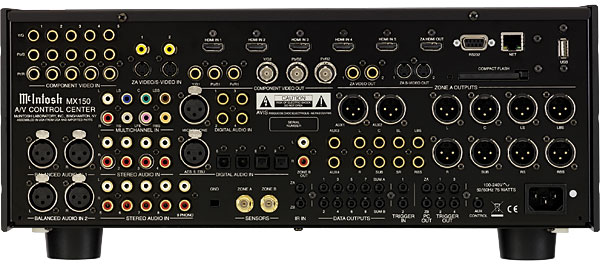| Columns Retired Columns & Blogs |
Music in the Round #46 Page 3
Second, after RoomPerfect calculates its corrections, you can take additional measurements to enhance its accuracy, or add more Focus points to have it develop corrections for other listening positions. Each resultant correction can be named descriptively and recalled as needed. At an early demo of RP, I found that sitting only a seat or two off the Focus resulted in an audible corruption of the acoustics; apparently, the newer version of the software incorporated into the MX150 doesn't suffer from this foible. Now when I sat off center, the correction wasn't optimal, but it was still better than no RP at all.
Third, as noted above, and other than taking into account the number of speakers used, RoomPerfect does not calculate or interact with speaker setup—you can run RP, which always does a full-range correction, and still tweak all other settings.

The fundamental sound of the MX150, with or without RoomPerfect, was smooth and wide-range, with discrete detail and a seamless soundstage. From about 300Hz up, the MX150 favored no part of the audioband over another, and permitted the differences among sources and ensembles to be easily resolved. I was particularly struck by the solidity and depth of central images, regardless of whether the source was recorded in 2.0, 4.0, 5.0, or 5.1 channels. Indeed, without putting an ear to the center-channel's tweeter, it was often difficult to distinguish 4.0 from 5.0.
The MX150's performance below 300Hz, without RoomPerfect, was good but a bit bumpy, and though this was ascribable to my room's dimensions, the lumps seemed discrete and identifiable instead of the usual muddled boom. Using my first RP correction of only 90%, the bottom end smoothed out considerably, and a granitic low-frequency extension emerged from the muck. Nonetheless, one room mode at about 40Hz seemed to add an occasional unnecessary thud. I figured that RP was an improvement but not perfect. XTZ measurements showed that the room response had peaks at 26 and 42Hz; while RP eliminated the 26Hz bump, it ameliorated the one at 42Hz by only about 3dB. However, Ron Cornelius of McIntosh suggested by e-mail that I take at least one measurement with the mike about a foot from the ceiling, aimed obliquely. I did that, and added two more elevated measurements (something that is anathema for Audyssey, by the way). This is when RP's "room knowledge" went to 96%; that 42Hz bump, presumably related to a mode in the vertical dimension, dropped another 4dB; it was still measurable but barely audible. In addition, the entire response below 100Hz was now lowered to match the level of the spectrum above. Overall, the bass correction was now measurably better at the Focus position, and less good but still working off axis.
While RoomPerfect had also made subtle corrections above 100Hz, the characteristic sound of my Paradigm Studio/60 front loudspeakers was unchanged, other than a slight smoothing of the midrange. Viewing the wide-range measurements in XTZ, it was apparent that RP had done a lot of smoothing and leveling between 300Hz and 1kHz, but very little above. I could see no significant corrections above 1kHz, on or off axis. The effect of RP correction was most noticeable in voice fundamentals, but it had little influence on sibilants, which served to retain intelligibility and maintain the personality of the loudspeaker. On the other hand, because RP's touch appears to lighten as the frequency rises, off-axis correction in the midrange was only marginally less effective than at the Focus position. The overall result with the MX150 and RoomPerfect was sound as clean, lively, and uncolored as I have heard from these speakers in this room.
I emphasize that RoomPerfect's lack of significant equalization above 1kHz is not necessarily an advantage or a disadvantage, but just one way of electronically dealing with room acoustics. Audyssey, for example, works only full-range, albeit with a lighter touch in the treble than at lower frequencies. Anthem Room Correction can be set to work only below a selectable frequency, though I found it most satisfying when applied up to at least 10kHz. There are many people who abjure any correction above the Critical Frequency (about 300Hz in most rooms), such as with Meridian's MRC. RoomPerfect offers yet another option, one that will suit those who want a bit more correction than just the bass, but insist on retaining the unique sound of the speakers they've so carefully selected.
My only caveats about the MX150 concern the incomprehensibly small and dim labeling of the remote control and the general lack of detail in the owner's manual. This is a powerfully flexible machine, and the manual doesn't begin to plumb its depths. Remember what I said about using the Aux outputs to biamp the front speakers? Aside from a label on a diagram indicating this capability, it's not mentioned in the manual. Similarly, explanations of the "voicing" options are brief to the point of obscurity. McIntosh's customer-service department lived up to its great reputation by quickly responding to my every e-mail inquiry—but why did I have to ask in the first place, and what did I not know to ask? I see a need for a second edition of the manual long before I see a need for an MX150 Mk.II.
I'm happy to give the highest marks to the McIntosh MX150 A/V Control Center with Lyngdorf Audio's RoomPerfect. Everything functioned properly, sounded superb, and was a pleasure to use. It looked good, too.
- Log in or register to post comments




































